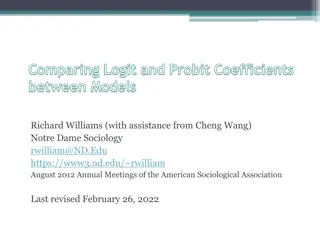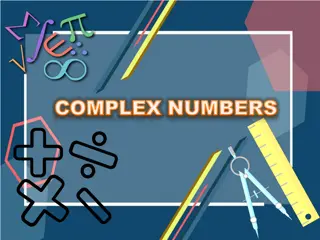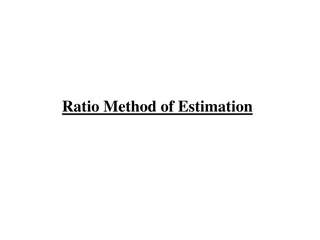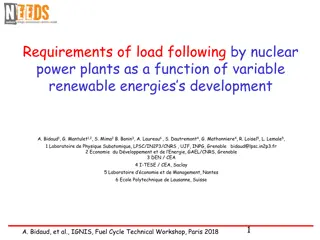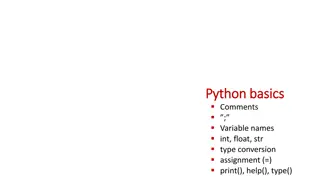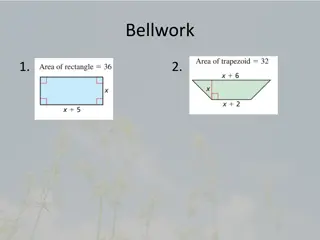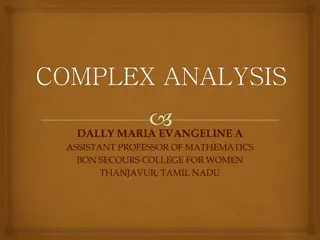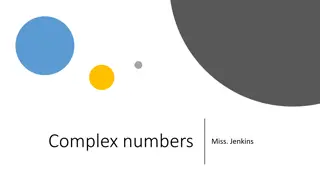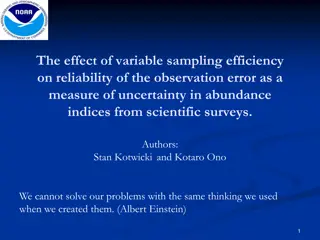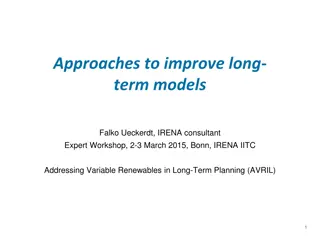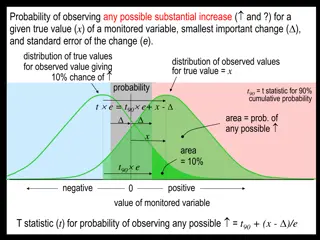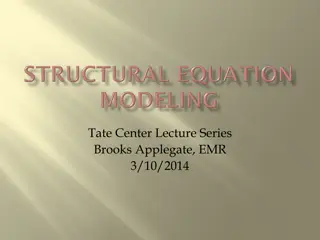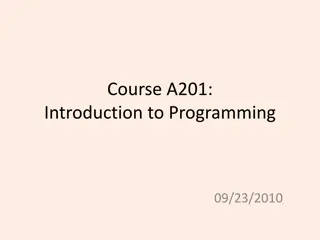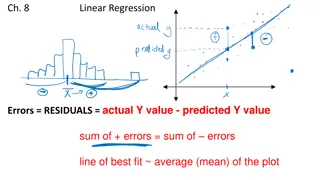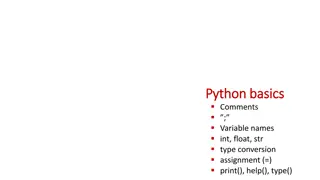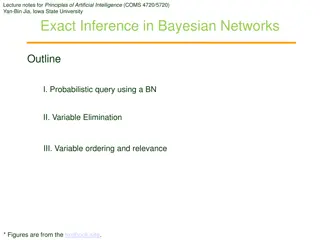Simple Mappings of Functions in Complex Variable Analysis
Exploring the concepts of translations, rotations, dilations, linear transformations, inversions, and their properties in mapping functions of complex variables. Learn how these operations affect points in the complex plane and their applications.
5 views • 27 slides
The Concept of Return to Factor in Production Economics
Return to Factor is a key concept in production economics that explains the relationship between variable inputs like labor and total production output. The concept is based on the three stages of production - increasing returns, diminishing returns, and negative returns. By analyzing the behavior o
3 views • 7 slides
Comparing Logit and Probit Coefficients between Models
Richard Williams, with assistance from Cheng Wang, discusses the comparison of logit and probit coefficients in regression models. The essence of estimating models with continuous independent variables is explored, emphasizing the impact of adding explanatory variables on explained and residual vari
3 views • 43 slides
Comprehensive Guide to Complex Numbers - Learning Objectives, Key Concepts, and Previous Knowledge Testing
This comprehensive guide provides detailed information on complex numbers, including learning objectives such as identifying complex numbers, applying algebra, understanding properties like conjugates and moduli, finding square roots, and representing in polar form. Key concepts covered include inte
7 views • 27 slides
Marginal Costing in Cost Accounting
Marginal Costing is a cost analysis technique that helps management control costs and make informed decisions. It involves dividing total costs into fixed and variable components, with fixed costs remaining constant and variable costs changing per unit of output. In Marginal Costing, only variable c
5 views • 7 slides
Assistant Professor Divya R. - Complex Analysis and Probability Course Overview
Assistant Professor Divya R. from the Department of Mathematics at K.S. School of Engineering and Management in Bengaluru presents a course on Complex Analysis and Probability. The course covers topics such as functions of complex variables, Cauchy-Riemann equations, properties of analytic functions
4 views • 27 slides
Ratio Method of Estimation in Statistics
The Ratio Method of Estimation in statistics involves using supplementary information related to the variable under study to improve the efficiency of estimators. This method uses a benchmark variable or auxiliary variable to create ratio estimators, which can provide more precise estimates of popul
3 views • 30 slides
2020 Company Confidential - Add-Ons and Variable Properties Guidelines
This document provides guidelines for add-ons and variable properties within the context of the 2020 Company Confidential data. It covers various aspects such as variable validations, logic return types, export/import considerations, and the handling of accessory items. The content emphasizes the pr
2 views • 39 slides
Load Following by Nuclear Power Plants in Relation to Variable Renewable Energies' Development
The study explores the requirements of load following by nuclear power plants in the context of variable renewable energies' growth. It discusses the impact of renewable energy development on nuclear economic models and the need for dispatchable capacities. Benchmarks are set to test robustness of d
3 views • 11 slides
Python Basics: Comments, Variable Names, Assignments, and More
Learn about the basics of Python programming, including the use of comments to explain code, defining variable names, type conversion, assignment operators, and general guidelines for coding practices. Explore how to effectively use comments to describe code functionality and understand the signific
9 views • 21 slides
Remediation Strategies for Part-Time and Variable Hourly Employees in Holiday Act Compliance
This case study delves into the challenges faced in managing leave liabilities for part-time and variable hourly employees under the Holidays Act 2003. It explores various working profiles such as split shifts, cycle shifts, variable shifts, and seasonal work, presenting issues in calculating leave
1 views • 18 slides
Endogeneity and Instrumental Variable Estimation Methods
Endogeneity in econometrics can create challenges such as omitted variables bias, measurement error, simultaneous causality, and using lagged values. This can affect the accuracy of models. One way to address this is through instrumental variable estimation methods. These methods help deal with endo
2 views • 42 slides
Complex Numbers in Mathematics
Learn about complex numbers, including real and imaginary parts, operations with complex numbers, the imaginary unit, equality of complex numbers, and finding square roots of negative numbers. Explore how to define and use the imaginary unit, add, subtract, and multiply complex numbers, find complex
12 views • 17 slides
COMPLEX ANALYSIS
Complex analysis explores the properties and behavior of complex functions and numbers. Topics covered include functions of complex variables, limits, continuity, and differentiability. Understanding concepts like the Cauchy-Riemann equation is crucial in studying complex valued functions. This fiel
3 views • 9 slides
Complex Numbers in Mathematics
Delve into the world of complex numbers through solving quadratic equations with real coefficients that have complex solutions, extending polynomial identities to include factoring with complex numbers, rewriting expressions, and understanding imaginary numbers. Discover the process of finding compl
25 views • 16 slides
Variable Sampling Efficiency in Scientific Surveys
Exploring the impact of variable sampling efficiency (qe) on the reliability of observation error in abundance indices from scientific surveys. Authors delve into the complexities of survey design, factors affecting qe, and the need to adapt to variable efficiency. Studies show both random and non-r
4 views • 29 slides
New Approaches in Learning Complex-Valued Neural Networks
This study explores innovative methods in training complex-valued neural networks, including a model of complex-valued neurons, network architecture, error analysis, Adam optimizer, gradient calculation, and activation function selection. Simulation results compare real-valued and complex-valued net
0 views • 12 slides
Enhancing Long-Term Energy Models for Variable Renewables
Explore approaches to enhance long-term energy models for integrating variable renewables in long-term planning. Key aspects include improving generation networks, ensuring sufficient capacity and reliability, flexibility, robustness to contingencies, and security considerations. Temporal matching o
5 views • 22 slides
Probability Scenarios for Monitoring Variable Changes
Explore various probability scenarios when observing substantial increases, decreases, or unclear changes in a monitored variable based on the true value, smallest important change, and standard error of the change. Understand the likelihood of different outcomes and how to calculate probabilities f
3 views • 5 slides
Latent Variable Modeling in Statistical Analysis
Latent Variable Modeling, including Factor Analysis and Path Analysis, plays a crucial role in statistical analysis to uncover hidden relationships and causal effects among observed variables. This method involves exploring covariances, partitioning variances, and estimating causal versus non-causal
3 views • 59 slides
Introduction to Programming
Today's course introduces programming concepts like using break and continue in while loops, logical operators, and variable naming conventions. Assignment 1 covers topics such as data types, variable naming best practices, and error handling when working with strings and floating numbers. Examples
1 views • 15 slides
Linear Regression
Linear regression is a fundamental statistical technique used to analyze the relationship between variables. This method involves calculating the line of best fit that minimizes the sum of squared errors to predict the response variable based on an explanatory variable. The least squares regression
1 views • 25 slides
Variable Neighborhood Search Techniques in Optimization
Variable Neighborhood Search (VNS) is a powerful optimization technique that involves changing the neighborhood during the search process. This approach is based on the observation that a local minimum in one neighborhood structure may not be globally optimal. By exploring different neighborhood str
1 views • 69 slides
Challenges in Reverse Engineering
Reverse engineering is a complex process that involves deciphering code, binary logic, and ambiguous representations. It poses difficulties such as loss of information, lack of variable/function names, and ambiguous code representations. The comparison between static and dynamic analysis sheds light
8 views • 10 slides
Structural Variations in Interaction Effects within the Motorpool Dataset
In the context of the Motorpool dataset, structural variations and interactions are explored, focusing on how the effect of one explanatory variable on the dependent variable can change based on another variable. The technique involves introducing the product of the two variables as a new artificial
0 views • 7 slides
User Input and Variable Scope in C Programming
Explore the concepts of user input handling using scanf function in C programming, along with the limitations of variables and implications of variable scope. Learn how to read multiple values with scanf, format string patterns, and understand variable visibility within different parts of a program.
2 views • 24 slides
Understanding Omitted Variable Bias in Regression
Omitted Variable Bias (OVB) occurs when a crucial variable is left out of a regression model, leading to biased estimates. The OVB formula highlights the conditions where bias may occur and suggests solutions such as including the omitted variable or utilizing Instrumental Variables (IV) to account
0 views • 7 slides
Variable Scopes in Programming
Explore the concept of variable scopes in programming, how they affect the lifespan and visibility of variables within different blocks of code, and best practices for handling variable declarations effectively. Learn about local and global scopes, reuse of variable names, and common approaches for
1 views • 34 slides
Complex Numbers in College Algebra
Explore the world of imaginary and complex numbers in college algebra, including the concept of imaginary numbers, complex numbers, plotting complex numbers, adding, subtracting, multiplying complex numbers, and dividing complex numbers. Discover how to represent and operate with complex numbers eff
1 views • 17 slides
Python Basics: Comments, Variable Names, and Assignments
Learn about Python basics including comments usage, variable naming conventions, type conversion, and assignment. Understand the significance of comments in code documentation, valid variable names in Python, and the correct usage of assignments. Explore the fundamentals of Python programming and im
2 views • 21 slides
Latent Variable Models in Educational Research
Explore the concept of latent variable models in educational research through modeling item response profiles using factor models, latent class models, and latent variable hybrids. Learn how these models can be applied in practice to analyze item response data and uncover patterns in examinee classe
2 views • 25 slides
Variable Selection in Regression Analysis
Explore the importance of variable selection in regression analysis, including methods like stepwise regression and criteria for deciding which variables to include. Learn how to assess model success using R2 and adjusted R2, and the significance of p-values in determining variable importance.
3 views • 42 slides
Exact Inference in Bayesian Networks: Probabilistic Query and Variable Elimination
Learn about exact algorithms for posterior probability computation in Bayesian networks through probabilistic queries, variable elimination, and inference techniques such as enumeration and variable ordering. Explore examples and expression trees to understand computations and algorithmic strategies
1 views • 14 slides
Understanding Variables and Variable Naming Conventions in Shell Scripting
Learn how to create and manage variables in shell scripting, including naming conventions, assignment, and reading variable content. Explore best practices for naming variables and constants, as well as how to perform multiple variable assignments efficiently.
4 views • 6 slides
Understanding Variable Mutation and Object Immutability
Explore the concepts of mutation and immutability in programming through examples of sharing, mutability, immutability, copying, and object identity. Learn the differences between variable reassignment and object mutation, as well as the significance of object identity in programming. Understand how
3 views • 17 slides
Understanding Variable Reassignment vs. Object Mutation in Python
This content explores the concepts of variable reassignment and object mutation in Python programming, highlighting the distinction between changing variable bindings and mutating objects. Examples and illustrations demonstrate how these operations work differently and affect data structures.
4 views • 18 slides
Understanding Variable Scope in Python
Explore the concept of variable scope in Python, encompassing local and global variables, function scopes, and nested scopes. Understand how variables are bound within different areas of code and learn techniques for managing variable scope effectively. Dive into practical examples illustrating the
0 views • 9 slides
Understanding Variable Types and Definitions in C++ Programming
Learn about variable types, definitions, and declarations in C++ programming, including how to declare, define, and initialize variables. Explore the basic types of variables, proper naming conventions, and the importance of variable declarations for efficient program compilation and linking.
0 views • 9 slides
Mastering Variable Selection with Random Forest in SAS
Explore the power of Random Forest in SAS for variable selection, as explained by statistical research analyst Denis Nyongesa. Learn how Random Forest techniques improve prediction models by selecting important variables and discover the significance of variable importance measurement. Enhance your
1 views • 14 slides
Complex Numbers in Quadratic Equations
Explore the nature of roots in quadratic equations, solve equations with complex roots, understand complex conjugates, and discover properties of complex numbers. Dive into conjugate pairs, complex roots of quadratics, and conjugate pairs of roots in polynomial equations with real coefficients.
0 views • 9 slides


